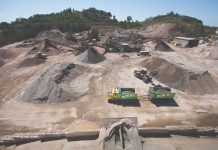
Deakin University researchers have found a novel way of turning per-and poly-fluoroalkyl (PFAS) decontaminated soil, heat-treated to destroy PFAS, into an alternative for fine aggregate in concrete.
PFAS compounds, which have been manufactured and used in a variety of industries around the globe, for example in firefighting foaming agents and manufacture of carpets, are now present in soil, air, surface water, groundwater and in some places, drinking water.
Thermal destruction treatment is currently the only way to completely decontaminate PFAS polluted soil, but it effectively ruins the soil and makes it unsuitable for growing crops.
Constructions sites worldwide are removing tonnes of PFAS contaminated soil and sending it to landfill, which raises concerns around long term health and environmental exposure by PFAS, as seen in Melbourne with its problems getting rid of PFAS-contaminated soil from the West Gate Tunnel and Rail Tunnel projects.
Associate Professor Will Gates, a researcher with Deakin’s Institute for Frontier Materials, has led an Australian Research Council supported study that found a way of turning PFAS decontaminated soil into an alternative for fine aggregate in concrete.
“Our study has shown that the millions of tonnes of PFAS contaminated soil currently being disposed in increasingly limited landfill at a relatively high cost and potentially posing long-term environmental and health concerns, could instead be re-used in concrete, after heat treatment to destroy PFAS, for major projects such as the North East Link and the Rail Link planned for Melbourne over coming decades. Even sound barriers on our roads,” Associate Professor Gates said.
“This is a win-win for governments and the construction industry as well as the environment.”
Working with The Remediation Group and Victoria-based Renex Op Co Pty Ltd, the researchers found the contaminated soils, when pyrolytically heated to 600 degrees Celsius to vaporise the PFAS compounds with the PFAS-laden vapours and then combusted at 1200 degrees, were a ‘viable replacement for fine aggregate in concrete’, for which there is a worldwide shortage.
When tested against traditional aggregates in concrete, the heat-treated and decontaminated soils have been found to have equivalent hardened and structural integrity properties to reference concrete – following VicRoads, Australian and international standards.
Associate Professor Gates said he and his colleagues are now looking to conduct large scale testing of the long-term durability of concrete using these heat-treated soil as fine aggregates.
Concrete is the most widely manufactured material on the planet, with the cement and concrete making industry accounting for about 5-8% of the total global CO2 output.
“Though the concrete industry globally has made steps to reduce its carbon footprint where it can, the re-use of treated PFAS decontaminated soil would contribute to further reducing that footprint, rather than it going untreated to landfill,” Associate Professor Gates concluded.


















